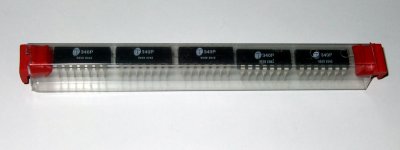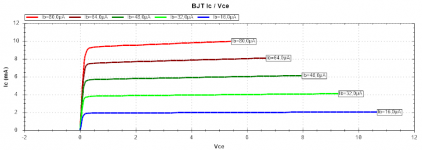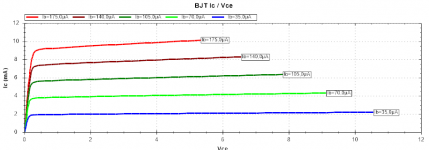I haven't noticed these THAT200 input transistors before. Jim used 2sk389'ers. I have to check them out for comparison.
Regards
THAT300 rather. There is a PNP NPN monolithic pairs array package too. Named 340P. The NPN got about 125 HFE and the PNP about 60 HFE in my samples. Their curves show same shapes but at different Ib currents of course.
Attachments
I'm surprised that tantalum capacitors are chosen for signal coupling. Especially in a high performance circuit.
Somewhere (was it AofE? Filter handbook?) it stated that tantalum was pretty much not a good capacitor for anything except power decoupling. That has been my experience as well. But, of course, maybe I have no experience with a "wet slug tantalum" What is that?
They don't mention polypropylene but it would seem to be the logical choice here. Not sure what they actually tried when they mentioned: polyethylene-terephthalate film. What manufacturer's line might that be?
Somewhere (was it AofE? Filter handbook?) it stated that tantalum was pretty much not a good capacitor for anything except power decoupling. That has been my experience as well. But, of course, maybe I have no experience with a "wet slug tantalum" What is that?
They don't mention polypropylene but it would seem to be the logical choice here. Not sure what they actually tried when they mentioned: polyethylene-terephthalate film. What manufacturer's line might that be?
Ok, thanks got it, as I thought...ask the expert.
Dan.
The trick is to minimise any inductive loops, the smaller they are the less affect they can have on other circuitry and the effect other circuitry can have on that loop, whilst avoiding or minimising capacitive coupling.
As to expert, Henry Ott, Ralph Morrison et al. are the real experts, my experience is many decades of having to achieve good EMC on real boards, I'm not hot on the maths or the theory but have developed a feel for how routing and copper pours should be to achieve the best signal integrity and EMC compliance. I sort of take the theory and guidelines and make pretty pictures of them.
I'm surprised that tantalum capacitors are chosen for signal coupling. Especially in a high performance circuit.
The circuit is for measuring noise, so perhaps linearity is a lesser concern. Jim Williams used a $400 1,300uF wet slug tantalum in his noise measuring apparatus for its very low dielectric absorption. See page 7:
http://cds.linear.com/docs/en/application-note/an124f.pdf
Polyethylene teraphthalate is the chemical name for polyester resins -- DuPont's trademark for polyester film is Mylar, and Dacron for yarns and staple.
Last edited:
Hofer in his AP Analog Master Class ppt has a few tricks to add to layout for lower net loop area
most external fields will be pretty uniform by smt local PCB wiring standards and you can "twist" trace loop to get some cancellation
TI introduced a new audio opamp , OPA1622,with a layout oriented toward reducing the exposure to external fields -- one of the folks on the team at TI started a thread on DIYAUDIO.
Jim Williams used a $400 1,300uF wet slug tantalum in his noise measuring apparatus for its very low dielectric absorption. See page 7:
Jim mourns the loss of polystyrene, I found a place that has a large collection of 1% to 2.5% NOS TRW poly caps at very low prices. I only had to buy a few extra to get a couple of RIAA networks better than .2% or so. I was a little lucky, the 9375pf read 9375pf exactly on my bridge. The folks were very helpful too.
https://www.surplussales.com/cgi-bin/cart.pl
Last edited:
Electronic Surplus, I have been shopping there since the 1960's.
The search function seems to be acting strange today.
Capacitors
The search function seems to be acting strange today.
Capacitors
Electronic Surplus, I have been shopping there since the 1960's.
The search function seems to be acting strange today.
Capacitors
Kevin -- I started going there when they were on Bolivar when I was in high school at Ignatius! They then moved to my Mom's ancestral homeland on Broadway. Every visit to CLE would entail a trip with my 3 sons to ES.
We had dinner at Lola's last week!
- Status
- This old topic is closed. If you want to reopen this topic, contact a moderator using the "Report Post" button.
- Home
- Design & Build
- Equipment & Tools
- 2nV/Rt Hz Noise Measurement


